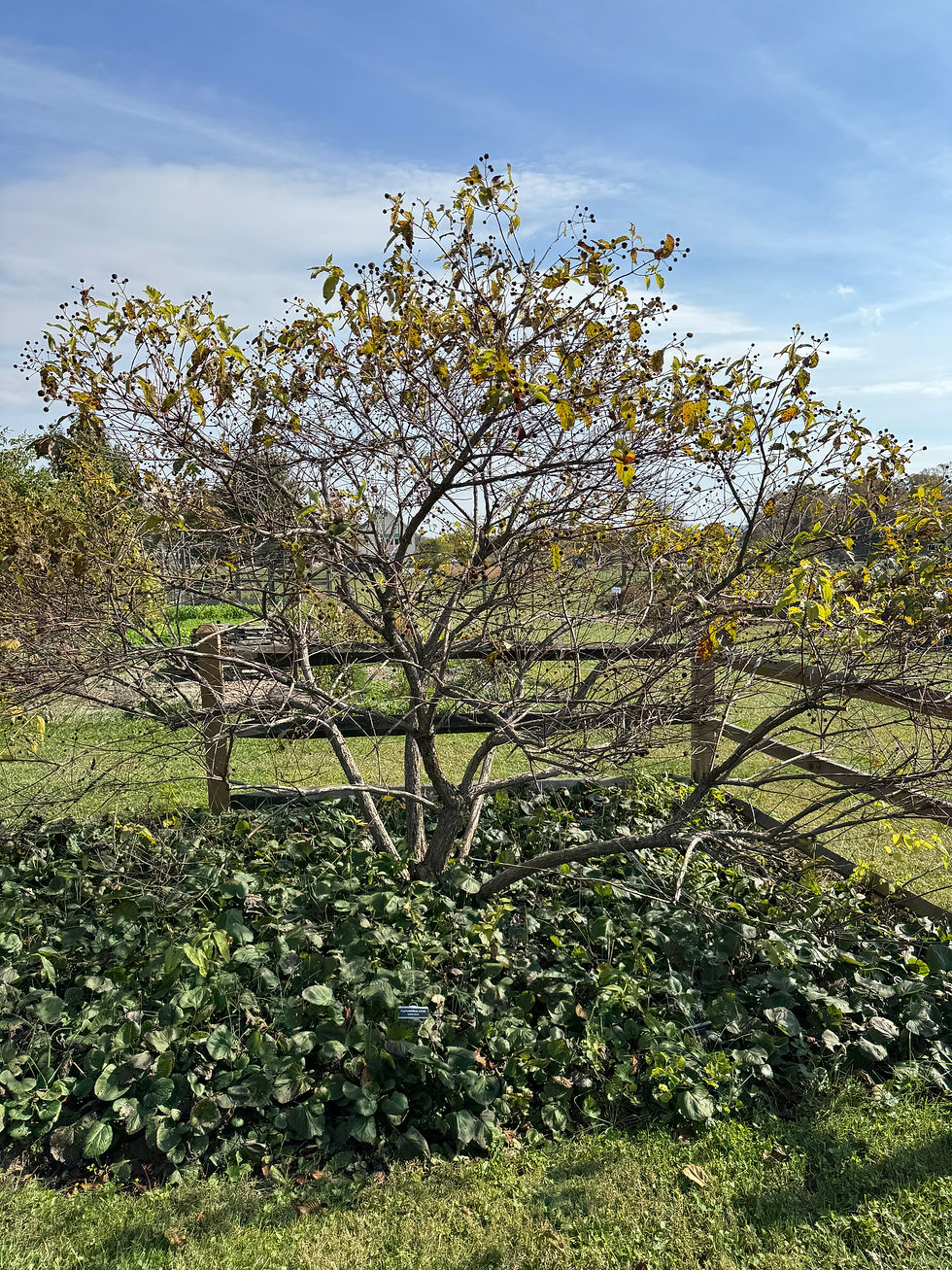Seeing the Right Native Plant in the Right Place
- Nuts for Natives
- Oct 29
- 4 min read
Updated: Nov 6
The key to a thriving garden.
As I observed my native rhododendron in its moist shady front garden corner a few days ago, I thought, still there but far fewer branches than when planted three years ago. Despite rhododendrons thriving in moist, shaded acidic soil, and my garden having no acidic soil whatsoever, I once again could not resist trying one. Still there? Yes. Thriving. Definitely not! It reminded me about the gardening adage we always hear and I mention in these posts often, if you get the right plant in the right place, it will thrive and your garden will as well. Let's face it. That is the vaguest advice ever!
It could take years of gardening experience to assess soil conditions, moisture and temperature, drainage and more in your garden and then you have to get just the right plants for those conditions. There is so much trial and error involved. And the "errors" are really all positive because you can learn so much from them.
Fortunately, we also have numerous ways to speed up our knowledge gains and get outside! If you find yourself out in nature, you may notice sensitive ferns (Onoclea sensibilis) clumping in moist ditches or goldenrods (Solidago) growing on dry slopes. This is one way to see where plants thrive.
Visiting any of the incredible array of large public native plant gardens and natural areas from the US Botanical Garden in Washington D.C. to Adkins Arboretum on Maryland's Eastern Shore up north to the Delaware Botanical Gardens and Mt. Cuba Center in Delaware and Stoneleigh garden in Pennsylvania, just to name a few, can provide a camera phone full of inspiration. These are native plants on a grand scale.
Another option is visiting smaller local demonstration gardens to see what they are growing. A couple of plusses -- perhaps a quicker option and also, there is greater chance of seeing plants growing in conditions that may be more similar to our own gardens. Two central Maryland gardens aimed at education are really showing off their autumn native plant stuff right now. These are great opportunities to see what is growing where. And, because education is their goal, they have signage and other helpful information to figure out whether the plant on demonstration can work for you.
Center for Maryland Agriculture and Farm Park
The demonstration gardens at this 140 plus acre farm park in Cockeysville in Baltimore County are filled with native plant ideas. Such great labeling of plants and a lot of very mature plants make this worth the visit. It's really helpful to see what plants look like 5 and 10 years in. In addition, all of the plants on demonstration are widely available.
A quick look-up of buttonbush (Cephalanthus occidentalis) tells us the shrub thrives in moist soils and full sun. Here it is clearly in full sun and also underplanted with golden groundsel, a moisture loving spring blooming perennial. You can read more about golden groundsel here. Seeing moisture loving plants thriving in full sun locations tells us that these plants, with irrigation, can thrive. Since this demonstration garden does not appear to be a boggy site, it indicates both of these plants can tolerate average moisture levels.
These two shrubs, ninebark (Physocarpus opulifolius) and possumhaw viburnum (Viburnum nudum), are two more examples of mature native shrubs thriving in full sun. Both shrubs can also grow in part shade and do well in moist soils. Seeing them in this full sun garden plot shows, with watering, they can be adaptable.
There are many plants on demonstration and many sustainable garden practices on display as well. If you are wondering about which perennials to pair, how it might look to leave seed heads standing or what full grown native shrubs look like, this is a good place to check out.
Robinson Nature Center
Robinson Nature Center in Columbia in Howard County Maryland is another trove of ideas. The Nature Center is surrounded by a mile of trails that weave among a number of native plantings. The plants are marked. The walk starts by a lovely waterfall and pond and affords views of the Patuxent River.

The pond is surrounded by moisture loving perennials such as northern sea oats (Chasmanthium latifolium), joe pye weed (Eutrochium purpureum) and pickerel weed (Pontederia cordata). This is a very naturalistic setting and shows you where native plants would grow in the wild.
It is interesting to see the popular native grass, northern sea oats, in a setting that could be natural. A plant or two tucked between moist crevices created by rocks surrounding the pond make the grass look very much at home. I have seen norther sea oats planted in garden borders, and while beautiful, it didn't, to my eye, look very much at home. Tucked in and among boulders it does.

The paths include many of the keystone native plants, those that have outsized ecological benefit compared to other native plants. In addition to seeing how native plants grow in a more wild setting, if you decide to visit the Nature Center, you can also avail yourself of the free native seed library!
These are two very different places with similar goals for gardeners, to make it easier to grow with natives. The Chesapeake Watershed is filled with places like these. If you have a local favorite garden for native plant inspiration, please do share. We will all appreciate it!
Happy Gardening.











































I second Patty's excitement that you visited the Baltimore County Master Gardeners Demo Garden in Hunt Valley! We are super proud of that space and grateful to share it with the public, sunrise to sunset, all year round.
The Maryland Native Plant Society runs monthly field trips all over the state. These can be good places to see native plants in their natural setting. Also, on the Eastern Shore, Adkins Arboretum, mentioned in the posting, has acres of native plants that are beautiful examples. I also encourage people to go on garden tours. The Lower Shore Land Trust does a tour every summer. While not all the gardens emphasize native plants, many do.
That possumhaw viburnum is gorgeous!
I'm so happy you came to visit the Demonstration Garden planted and cared for by the Baltimore County Master Gardeners! It really is an amazing garden. A new project is a lawn alternatives demonstration space, as well as a deer-resistant garden and an orchard. We love our visitors!.
My volunteer chasmanthium latifolium grows in one dry woodsy area, but not the other. I think it gets a little bit more sun, and enough water in the spring. There are a couple dense stands of them despite the lack of water.